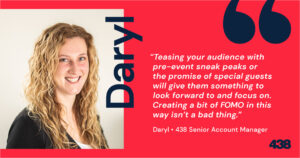Search ‘virtual events’ and you’ll find reams of stories about how COVID-19 changed everything for the events industry forever. How lockdown forced the cancellation of exhibitions and conferences worldwide, and in turn forced them online – often for the first time. While that’s all very true, there’s a flipside worth thinking about, too.
The fact is, this ‘new’ digital normal has been business as usual for many companies long before the pandemic. Whether it’s multi-location organisations running internal events for staff around the world, or global brands hosting virtual events for external customers and audiences, they’ve been doing it for years, been doing it well – and with the advancement of digital technology – are leading the way in doing it even better and better all the time.
Opening up opportunities
At 438, we’ve been working closely with clients, like PepsiCo, to plan and stage global virtual events for many years now. Partly in response to the pandemic, but more so as a way to go beyond day-to-day Zoom calls to help galvanize a global workforce – saving time and money while making opportunities even more accessible to more people in more places, everywhere.
So, when it comes to considering what makes a virtual event a very ‘real’ success, we think learning from both the trailblazers and post-pandemic adopters – like our friends at PepsiCo – is a good place to start. After all, it’s a way of working that’s here, and very much here to stay. So much so, the share of virtual marketing events worldwide has been projected to be *40% – and when we’re talking about a global exhibition market that’s worth $14bn USD, that’s not nothing.
The secrets to virtual success
We went straight to the source here at 438, asking the virtual event experts within our team about their firsthand experience of delivering virtual events with success – and this is what we’ve arrived at.
- Create a collaborative comfort zone
We’re not talking about ergonomic home-office chairs (although it helps). We’re talking about making the people who show up to your virtual events feel at ease, which makes it more likely they’ll tune in and take part.
“The way we act in person isn’t always how we act online,” something 438 Account Director Alissa has observed while working on high-profile global events with PepsiCo.
“But there are some really simple things event organisers can do to help make this happen. Like planning ahead to have ‘friends’ kick things off and keep things moving in the live chat during the event. It’s a great way to spark conversation and can go a long way to giving people confidence to join in, have a voice, and feel valued – all good things to boost engagement.”
According to Daryl, 438 Senior Account Manager, it’s also about giving people a reason to show up in the first place. “Teasing your audience with pre-event sneak peaks or the promise of special guests will give them something to look forward to and focus on. Creating a bit of FOMO in this way isn’t a bad thing.
“Inviting a guest to break up the content and inject some fresh energy into the event can also keep people interested – and in turn comfortable with the format.”

- Breathe and let breathe
It’s one thing promising an event that’s packed full of incredible content, and another making it so jam-packed that it overwhelms. Screen fatigue is real and worth bearing in mind when scoping out a virtual event. Watch-worthy content will quickly lose its appeal if it gets weighed down by information-overload.
“It’s really important to keep content short, snappy and interesting.” Sound advice from 438 Account Manager Georgia. “No one wants to sit and listen to someone talk through a 50-slide deck. It’s about delivering content in small chunks with changes in pace and format along the way. A short presentation could be followed by a video, then an interactive discussion, for example. It’s about being creative and giving your content and audience space to breathe. And make sure that you’re really objective when planning the agenda in the first place, it’s easy for the agenda scope to creep and before long you’re trying to say or achieve too much in too little time so be really disciplined with what makes the cut.”
438 Account Director, Jake, adds that timings are key, too. “Rehearsals are crucial for knowing if speakers are likely to run over or under their time allocation. Knowing this before going live will allow you to put contingencies in place. Because no matter what, the audience’s time must always be respected.”
- Excite and ignite with purpose
As the saying goes, content is king. And content for a virtual event is no exception. PowerPoint has its place, but it’s always worth thinking beyond a deck of slides. Think keynote speakers, panel discussions, video content, visual stimulus, interactive elements and memorable experiences.
“At the end of the day, we want audiences to feel like they’re getting value from the event – that it’s worth their time and attention,” says Georgia. “There’s no way around it. It just has to be worth it.”
Jake adds: “Absolutely, but let’s not forget post-event comms too. It’s not just about what you deliver in the moment, but what you leave people with and provide them with later. Plus, not everyone invited will be able to attend on the day. So following up with relevant communications after your event will reinforce its value and give people a reason to come to the next one.”

- Be prepared… and ready for anything
Like anything, the best laid plans can take an unexpected turn. The thought of the unknown alone can be enough to spark and inflame pre-event jitters. But the good news is, there are some simple things you can do to keep your plan on track and make sure you’ve got back up if things do go awry.
“Plan. Plan. Plan. There’s no substitute for being prepared,” Daryl recommends. As well as making sure all the pieces are in place, “it’s ensuring content is signed off at least a week before the event to allow for any last-minute changes – especially for external speakers. Although, we do live in the real-world here and it’s not unusual for decks to be changed the night before an event, it’s definitely best practice!”
Alissa adds: “The one thing you don’t want to hear on the day is ‘Oh! I thought you were doing that.’ Having a clear RACI (Responsible, Accountable, Consulted, and Informed) framework in place for the events team will take care of that. It’ll be your lighthouse for who’s who and doing what – from who’s running the show and who’s keeping time, to who’s managing all the content.”

“With virtual events being global, there’s different time zones to think about, too,” adds 438 Senior Account Manager, Sophie. “That’s why is vital to have a tight team ready and able to help with any of those unplanned detours and even emergencies, like artwork amends.”
Jake agrees adaptability can be a superpower when the unexpected strikes. “Producing successful live events is about adapting to changing variables. Control what can be controlled and have contingencies in place for the things you can’t. If a speaker’s internet connection drops out, for instance, have your next agenda item ready in the wings.”
While keeping a cool head in these moments doesn’t often come naturally, Alissa believes it’s a skill worth mastering. “Things can and will change no matter how much you’ve planned. So expect the unexpected. Plan for the unplanned. And if (or when) the time comes that a curve ball comes your way, you’ll be in a position to catch it with confidence and calm.”
But at the end of the day, your audience will be more understanding and forgiving than you might think. “Just be yourself and handle unexpected moments in an authentic way,” says Jake.
- Power up with a virtual events partner
Planning, coordinating and staging an in-person event takes time, talent and know-how. It’s the reason event planners are rarely out of work. Virtual events are no different. It takes careful planning, organising, and capability to host a live event online – potentially to a global audience. But finding a great events partner who can help with all the heavy lifting can make all the difference.
The question is, how do you choose the right virtual events partner for you?
For starters, look for one with proven expertise in your market – or an appetite to learn all about yours. Ask questions about previous events they’ve worked on – what their level of involvement was, how they worked, what worked well, and what (if anything) they’d do differently in future. And ask to see testimonials and feedback from previous clients and event participants, along with metrics on engagement and ROI.
Without a doubt, the migration of events to virtual spaces has opened up limitless opportunities for brands and organisations to go beyond borders to collaborate, share, and learn together. But while it’s fast becoming the go-to platform for events, like anything in the digital world, it’s constantly changing and improving with technology. But we’re also always learning from every experience, and taking it forward to the next. Making the virtual events space a dynamic and exciting place to be working in.
